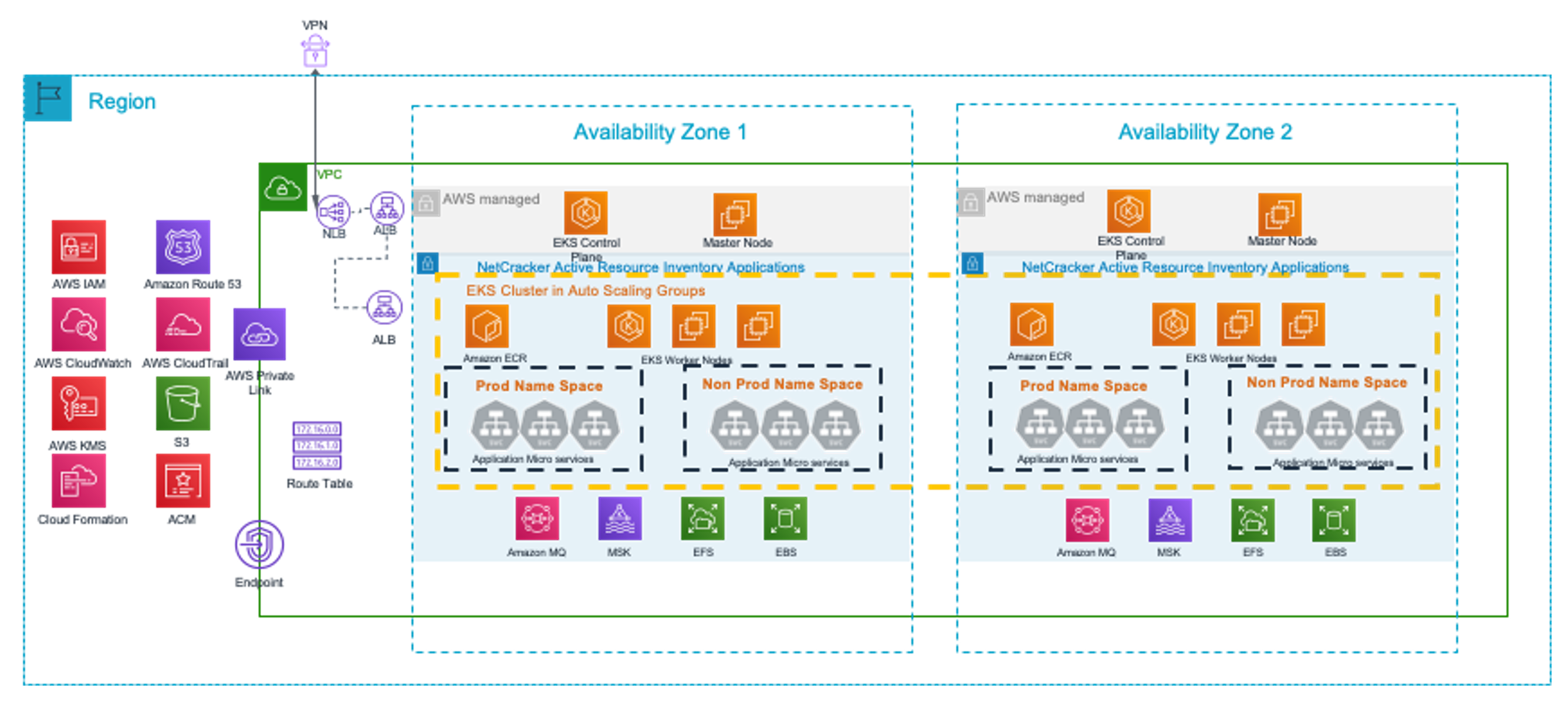Application architecture
The architecture diagram below shows the parts of the architecture
that make up an
Amazon EKS
Netcracker Active Resource Inventory supports deployment in production and non-productions namespaces per best practices. This supports isolation while allowing for better resource utilization to support a testing environment.

Kubernetes cluster high-level architecture
Netcracker active resource inventory users the following AWS services for its application layer:
-
Amazon Elastic Kubernetes Services (Amazon EKS)
is a service that makes it easy to deploy, manage and scale containerized applications using Kubernetes on AWS. Amazon EKS makes it easy to provision and manage the compute capacity for Netcracker Active Resource Inventory cluster with a single command. EKS manages worker nodes for Netcracker active resource inventory apps using latest EKS-optimized Amazon Machine Images (AMI) while node updates and terminations gracefully drain nodes to ensure Netcracker active resource inventory apps stay stable. -
Amazon Elastic Container Registry (Amazon ECR)
is a fully managed container registry that makes it easy to store, manage, and deploy Netcracker container images and artifacts. With Amazon ECR, Netcracker does not have the need to operate its own container repositories. Netcracker doesn’t worry about the scaling of the underlying infrastructure. Moreover, it simplifies distribution of containers to customers leveraging the Netcracker Active Resource Inventory/ AWS-powered solution. -
Amazon Elastic Compute Cloud (Amazon EC2)
provides secure, resizable compute capacity in the cloud. It provides the compute environment on which containers are managed. The required EC2 resources are created as needed by Amazon EKS, which manages the underlying resources required to run Netcracker active resource inventory. -
Amazon Elastic File System (Amazon EFS
) provides a simple, scalable, fully managed elastic NFS file system for use with AWS cloud services. It is built to scale on-demand to petabytes, without disrupting applications - growing and shrinking automatically as files are added and removed, eliminating the need to provision and manage capacity to accommodate growth. As Netcracker Active Resource Inventory apps create, modify and remove files, EFS supports its growth. -
Amazon Elastic Block Store (Amazon EBS)
provides persistent block-level storage volumes for use with EC2 instances in the AWS Cloud. Each Amazon EBS volume is automatically replicated within its Availability Zone to protect from component failure, offering high availability and durability. EBS volumes offer the consistent and low-latency performance needed to run workloads. -
Amazon Message Queue (Amazon MQ)
provides a managed message broker service for open-source message-broker software RabbitMQ that makes it easy to set up and operate message brokers in the cloud for the Netcracker active resource inventory AWS solution. Amazon MQ enables apps to communicate with complex messaging patterns and with low-latency, high availability and message durability. -
Amazon Managed Streaming for Apache Kafka (Amazon MSK)
provides a fully managed service that makes it easy to build and run applications that use Apache Kafka to process streaming data. MSK clusters are compatible with: -
Apache Kafka partition reassignment tooling
-
Apache Kafka APIs
-
Apache Kafka Admin Client
-
3rd Party tools
-
Message and retention limits are determined by apps configuration.